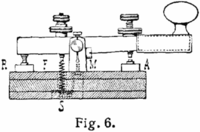


Z Code (like Q Code and X Code) is a set of operating signals used in CW, TTY and RTTY radio communication.
There are at least three sets of Z codes.
| 1. | One set of codes was originally developed by Cable & Wireless Ltd. (the Cable & Wireless Service Z code) for commercial communications in the early days of wire and radio communications.
Many of the old C&W codes are derived from mnemonics
The old C&W Z codes are not widely used today. |
| 2. | APCO[clarification needed] also developed a system of Z codes.[1] |
| 3. | NATO forces independently developed a later set of Z codes for military use and inter-language needs. The NATO Z codes are still in use, and are published in the unclassified document ACP-131. |
There are other sets of codes internally used by Russia's military and other operating agencies.
| Code | Meaning | Source |
|---|---|---|
| ZAL (...) ... | I am closing down (until ...) due to ... | C&W |
| ZAP ... | Work ...
|
C&W |
| ZBK | Are you receiving my traffic clear? | NATO |
| ZBK 1 | I am receiving your traffic clear | NATO |
| ZBK 2 | I am receiving your traffic garbled | NATO |
| ZBM 2 | Place a competent operator on this circuit | C&W |
| ZLD 2 | I cannot transmit pictures | C&W |
| ZSF ... (...) | Switch off ... (except ...)
|
C&W |
| ZBW ... | Change to backup frequency ... | C&W |
| ZBZ ... | Measure of printability
|
C&W |
| ZUJ | Stand by. | NATO |
|
| |
|---|---|
| Transmission methods |
|
| Notable signals |
|
| Other writing systems in Morse code |
|